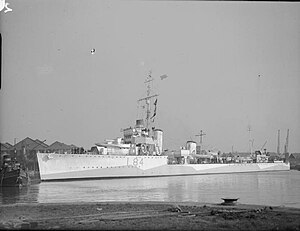This article includes a list of references, related reading, or external links, but its sources remain unclear because it lacks inline citations. (May 2012) |
 HMS Keppel
| |
| Class overview | |
|---|---|
| Builders | Thornycroft |
| Operators | |
| Preceded by | Admiralty V-class leader |
| Succeeded by | Admiralty type leader |
| Built | 1916–1925 |
| In commission | 1917–1945 |
| Planned | 7 |
| Completed | 5 |
| Cancelled | 2 |
| Lost | 1 |
| General characteristics | |
| Type | Destroyer leader |
| Displacement |
|
| Length | 329 ft (100 m) o/a |
| Beam | 31 ft 6 in (9.60 m) |
| Draught | 12 ft 6 in (3.81 m) |
| Propulsion |
|
| Speed |
|
| Range | 500 tons oil |
| Complement | 164 |
| Armament |
|
The Thornycroft type leader or Shakespeare class were a class of five destroyer leaders designed by John I. Thornycroft & Company and built by them at Woolston, Southampton for the Royal Navy towards the end of World War I. They were named after historical naval leaders. Only Shakespeare and Spenser were completed in time for wartime service. The other three were completed after the war, Broke and Keppel after being towed to Royal dockyards for completion, and two further ships - Saunders and Spragge - were cancelled. The function of a leader was to carry the flag staff of a destroyer flotilla, therefore they were enlarged to carry additional crew, offices and signalling equipment, allowing a fifth gun to be carried. These ships were very similar to the Admiralty type leader, but had Thornycroft design characteristics, the most noticeable being the broad, slab-sided funnels.
The design was used as the basis for several ships built for foreign navies in the 1920s.
- Regele Ferdinand-class destroyer built in Italy for the Romanian Navy
- Churruca-class destroyer built in Spain for the Spanish Navy and Argentine Navy
- Mendoza-class destroyer built in Britain for the Argentine Navy